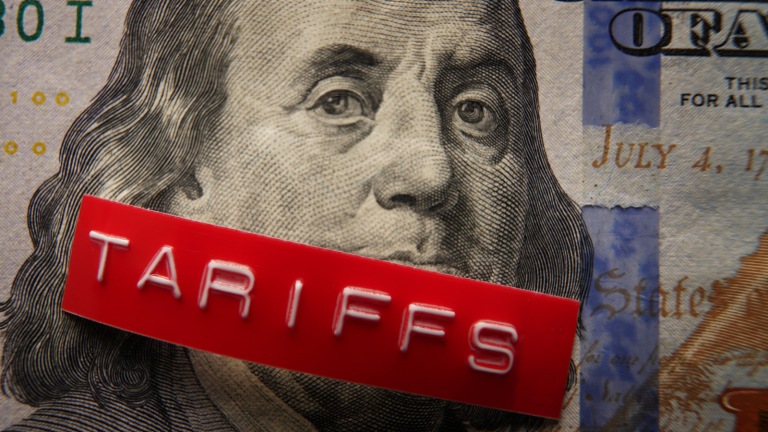Welcome to the ultimate Tariff Week, folks – perhaps the most dramatic episode of global economic theater since 2020’s COVID lockdowns began.
Tomorrow, Wednesday, April 2 is the big one: now known across trading desks as “Liberation Day.” That’s when U.S. President Donald Trump is expected to drop the hammer with a sweeping new set of tariffs that could restructure the entire global economic order.
Naturally, investors are nervous right now. And who can blame them?
The numbers tell the tale. The S&P 500 has cratered more than 10% from its all-time highs. The Nasdaq is down roughly 15%. And the Russell 2000? It’s flirting with a 20% nosedive.
That makes this the biggest market correction since 2022. And while volatility isn’t exactly a stranger to Wall Street, this one hits differently…
Because it’s not about interest rates, earnings misses, or some overhyped AI stock that turned out to be smoke and mirrors.
This is about the fundamental rules of global commerce being redrawn in real time.
The Tariff Toll on Markets
If you’ve been watching the markets over the past month, you’ve basically been locked into an emotional hypercoaster – with no safety harness.
It started back in February, when Trump floated the idea of universal tariffs on all countries and triggered a sharp leg down in stocks. Investors braced for a full-scale global trade war.
Then came the walk-back.
By mid-to-late March, the narrative had shifted to more “surgical” trade policy: targeted tariffs on the “Dirty 15” – the 15 countries with which the U.S. runs its largest bilateral trade deficits. That shift was enough to spark a brief but powerful relief rally, as cooler heads seemed poised to prevail.
But now? Here we go again.
Over the weekend, reports began circulating that Trump’s team was reconsidering the idea of blanket tariffs on all countries. This messaging unravelled the prior “targeted” narrative and sent markets plunging back to the March lows. It’s been a nonstop whiplash cycle of panic, hope, panic again; and no one knows what to believe anymore.
All these violent swings have left stocks in a very precarious – or maybe promising – technical situation…
What’s to Come on Wednesday
The S&P 500 has officially broken below its 250-day moving average for just the second time since this AI-fueled bull market began. That level has acted as the market’s trampoline in the past. But when it breaks? Things tend to go from bouncy to bloody in a hurry.

Historically, dips to this level result in one of two outcomes:
- A monster rebound rally that leaves short sellers in the dust; or
- The beginning of a true bear-market meltdown.
This is a technical tipping point. And with “Liberation Day” looming, the fundamentals are about to either validate or obliterate the charts.
So, with all this volatility, uncertainty, and tariff brinkmanship… are we panicking?
Not quite.
We still think Liberation Day won’t be nearly as bad as feared. Our take? Trump’s threat of universal tariffs is mostly bluster – an opening chess move, not checkmate.
Our base case remains:
- Tariffs will be targeted, not universal.
- The Dirty 15 get hit, but not the world at large.
- And once the dust settles, fast-and-furious negotiations will begin.
As painful as tariffs are for the U.S., they’re even more devastating for just about every other economy involved. Europe, Canada, South Korea, Japan – they have more to lose; and they know it.
These nations have significant export sectors, and a large portion of their GDP comes from trade. The U.S. also has a more diversified set of trading partners than many of these countries do. So, if tariffs are imposed on a particular country, it would likely be harder for it to replace lost business with the U.S. market.
That’s why we expect rapid deals, quick walk-backs, and a broader deescalation through April.
In other words, we’ve reached the climax of this trade war drama.
We’ve Reached the Pinnacle
Beyond the tariffs, it’s worth noting that the underlying fundamentals haven’t fallen apart. They’ve just been overshadowed by the panic.
- The S&P 500 is trading at 24X trailing earnings, right in line with its five-year average and roughly 10% cheaper than it was earlier this year.
- Forward earnings estimates are rising, not falling. The consensus forward 12-month EPS for the S&P 500 is now $278, up from $275 in mid-February – even after this correction.
- Wall Street still expects double-digit earnings growth: 10.2% in 2025 and 12.5% in 2026.
These aren’t the kind of numbers you see heading into a full-blown recession. That’s why we’re so confident that this is a market correction driven by fear, not fundamentals.
And historically, fear tends to create opportunities.

The Final Word on Tariff Week and Liberation Day
We’re standing at the edge of a cliff; no doubt. But we think the bridge will be built just in time.
Liberation Day may come with some fireworks. There may be scary headlines and continued market volatility. But the worst-case scenario likely won’t materialize.
Instead, we expect:
- Targeted tariffs
- Fast-tracked negotiations
- A return to risk-on sentiment by late April
And when that happens, stocks should roar back to life.
However, let’s be clear: if this tariff chaos drags on or Trump goes nuclear with trade policy, the market could go lower – a lot lower.
Goldman Sachs thinks we could be due for a ~50% drop in a worst-case scenario. That’s because, in a recession, earnings estimates tend to fall ~10% while valuation multiples compress meaningfully.
In a scenario where profit estimates decline ~10% and the S&P’s valuation multiple compresses to its 2018 low (the last time investors were really worried about tariffs), then that combination begets a nearly 50% market drop.

We think the odds of this worst-case scenario manifesting are very low – but not zero. That’s why we think you need to at least be prepared for this week’s potential fallout.
We’ve just created a brand-new special report – the Trade War Protection Playbook. This guide includes our top 10 favorite stock market plays to protect, even grow, your wealth if this global trade war gets worse tomorrow.
Get your hands on it before tomorrow’s tariffs hit the tape.
On the date of publication, Luke Lango did not have (either directly or indirectly) any positions in the securities mentioned in this article.
P.S. You can stay up to speed with Luke’s latest market analysis by reading our Daily Notes! Check out the latest issue on your Innovation Investor or Early Stage Investor subscriber site.

